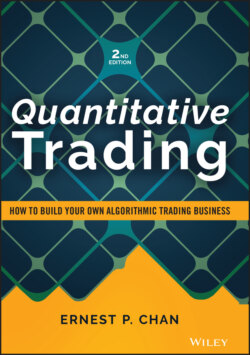Читать книгу Quantitative Trading - Ernest P. Chan - Страница 25
How Deep and Long Is the Drawdown?
ОглавлениеA strategy suffers a drawdown whenever it has lost money recently. A drawdown at a given time t is defined as the difference between the current equity value (assuming no redemption or cash infusion) of the portfolio and the global maximum of the equity curve occurring on or before time t. The maximum drawdown is the difference between the global maximum of the equity curve with the global minimum of the curve after the occurrence of the global maximum (time order matters here: The global minimum must occur later than the global maximum). The global maximum is called the high watermark. The maximum drawdown duration is the longest it has taken for the equity curve to recover losses.
More often, drawdowns are measured in percentage terms, with the denominator being the equity at the high watermark and the numerator being the loss of equity since reaching the high watermark.
Figure 2.1 illustrates a typical drawdown, the maximum drawdown, and the maximum drawdown duration of an equity curve. I will include a tutorial in Example 3.5 on how to compute these quantities from a table of daily profits and losses using either Excel, MATLAB, Python, or R. One thing to keep in mind: The maximum drawdown and the maximum drawdown duration do not typically overlap over the same period.
Defined mathematically, drawdown seems abstract and remote. However, in real life there is nothing more gut-wrenching and emotionally disturbing to suffer than a drawdown if you're a trader. (This is as true for independent traders as for institutional ones. When an institutional trading group is suffering a drawdown, everybody seems to feel that life has lost meaning and spend their days dreading the eventual shutdown of the strategy or maybe even the group as a whole.) It is therefore something we would want to minimize. You have to ask yourself, realistically, how deep and how long a drawdown will you be able to tolerate and not liquidate your portfolio and shut down your strategy? Would it be 20 percent and three months, or 10 percent and one month? Comparing your tolerance with the numbers obtained from the backtest of a candidate strategy determines whether that strategy is for you.
Even if the author of the strategy you read about did not publish the precise numbers for drawdowns, you should still be able to make an estimate from a graph of its equity curve. For example, in Figure 2.1, you can see that the longest drawdown goes from around February 2001 to around October 2002. So the maximum drawdown duration is about 20 months. Also, at the beginning of the maximum drawdown, the equity was about $2.3 × 104, and at the end, about $0.5 × 104. So the maximum drawdown is about $1.8 × 104.
